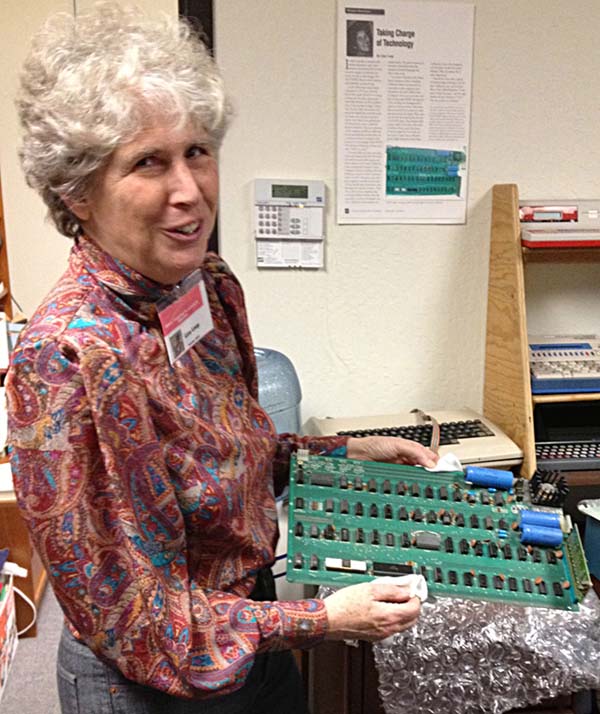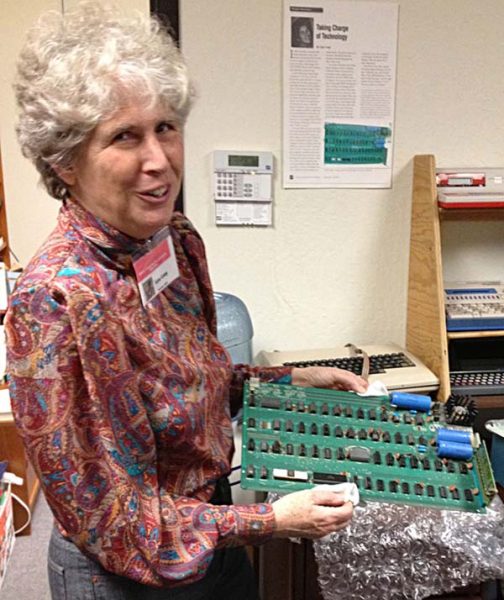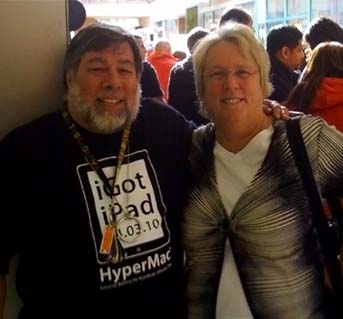Computer History

Liza Loop showing me the first Apple computer that Wozniak personally gave to her. Yes, it is just a PC board, no case, but it still works when hooked up to a power supply, keyboard, and a monitor. It was kept in Milpitas for many years until the Sobrato Center kicked out the little museum. This photo was taken in Milpitas.

Apple II History
This project began as a description of how the Apple II evolved into a IIGS, and some of the standards that emerged along the way. It has grown into a history of Apple Computer, with an emphasis on the place of the Apple II in that history. By Steven Weyhrich.
Atari Games Museum
The following pictures were taken in May of 2003, when Midway decided to close their Milpitas facility. The Milpitas facility was the old ‘Atari Games’ building. I was able to get some pictures, before everything was moved out of the building.
Chief Yahoos: David Filo and Jerry Yang
“Don’t put off until tomorrow what you can postpone to the day after.” This parody of the old proverb could very well be the motto of Yahoo! Inc. co-founders David Filo and Jerry Yang. By following such a philosophy of procrastination, they not only created the world’s most popular (and most profitable) World Wide Web search engine; they also made themselves multimillionaires in the process. Well, sort of.
Computer History Museum
Timeline of computing history, browse by topic, or send them information about computing history. Located in Mt. View.
Don Hoefler
The journalist credited with coining the phrase: “Silicon Valley.”
Folklore
Andy Hertzfeld’s book in blog format. Read about the origins of Apple and the Macintosh computer.
GoMilpitas Way Back
This site has archived my home page and some internal pages since 1999. If you’d like to see news headlines and such, take a look here.
Apple I replica creation: back to the garage
By Tom Owad. A Google book preview.
History of Computing Industrial Era 1976 – 1979
The Third Generation of computers starts approximately in this era. These computers are characterized by mainly electronic models but now fully programmable. From The History of Computing Foundation.
Homebrew Computer Club
That summer in 1975 at the Homebrew Club the Intel 8080 formed the center of the universe. The Altair was built around the 8080 and its early popularity spawned a cottage industry of small companies that either made machines that would run programs written for the Altair or made attachments that would plug into the various kinds of micro computers. Be sure to check out the early newsletters.
IBM’s Early History
In 1890 the U.S. Census Bureau knew its traditional methods of counting would not be adequate for measuring the population, so it sponsored a contest to find a more efficient means of tabulating census data.
IBM Through the Years
A timeline that begins in 1885 with short articles about this history of this business machine company.
An Illustrated History of Computers
The first computers were people! That is, electronic computers (and the earlier mechanical computers) were given this name because they performed the work that had previously been assigned to people. By John Kopplin.
Intel Museum
So you have “Intel Inside.” What exactly DO you have inside your computer?
The Jargon Dictionary
A comprehensive compendium of hacker slang illuminating many aspects of hackish tradition, folklore, and humor. This file, jargon.txt, was maintained on MIT-AI for many years, before being published by Guy Steele and others as the Hacker’s Dictionary. Many years after the original book went out of print, Eric Raymond picked it up, updated it and republished it as the New Hacker’s Dictionary.
Lawrence Livermore Labs History
The single event that triggered the establishment of Lawrence Livermore was detonation of the first Russian atomic bomb in 1949.
Lo*op Center
Once located in the Sobrato Center in Milpitas, under the direction of Liza Loop, documents, artifacts, and stories were preserved to tell the history of educational computing.
Memoir of a Homebrew Computer Club Member
Posted on a bulletin board in the PALY terminal room (containing 6 noisy KSR-33 teletypes in the Palo Alto High School math-science office) was a notice that a computer group meeting would be held at the home of Gordon French. By Bob Lash.
National Semiconductor History 1959 1960’s
National Semiconductor started by making silicon mesa transistors for industrial and military uses. The company grew quickly after 1967 under CEO Charlie Sporck and new management, moving headquarters from Danbury, Connecticut, to Santa Clara, California in the heart of today’s Silicon Valley.
Pong Story
The video game history started in a strange and complicated way and it is important to avoid confusions with what happened in the 1950s and 1960s. The real video game history started with Ralph Baer as early as 1951.
The Promise: An Educator’s History of the Internet
An investigation into the history of the Internet and the promise for its use in the K-12 classroom.
Silicon Genesis
A unique collection of oral history interviews with pioneers of the semiconductor industry.
Steve Paul Jobs
Like the Bhagwan, driving around Rancho Rajneesh each day in another Rolls-Royce, Jobs kept his troops fascinated and productive. The joke going around said that Jobs had a ‘reality distortion field’ surrounding him. He’d say something, and the kids in the Macintosh division would find themselves replying ‘Drink poison Kool-Aid? Yeah, that makes sense’. – Robert X. Cringely, 1992.

Steve Wozniak, Still Fathering the Computer Revolution
He’s been called the Wizard of Woz. It was he who single-handedly designed an entire personal computer, the Apple I. It was he who designed the Apple II and wrote the software to make it run. Site has more good Woz sites, including Steve’s own website.
